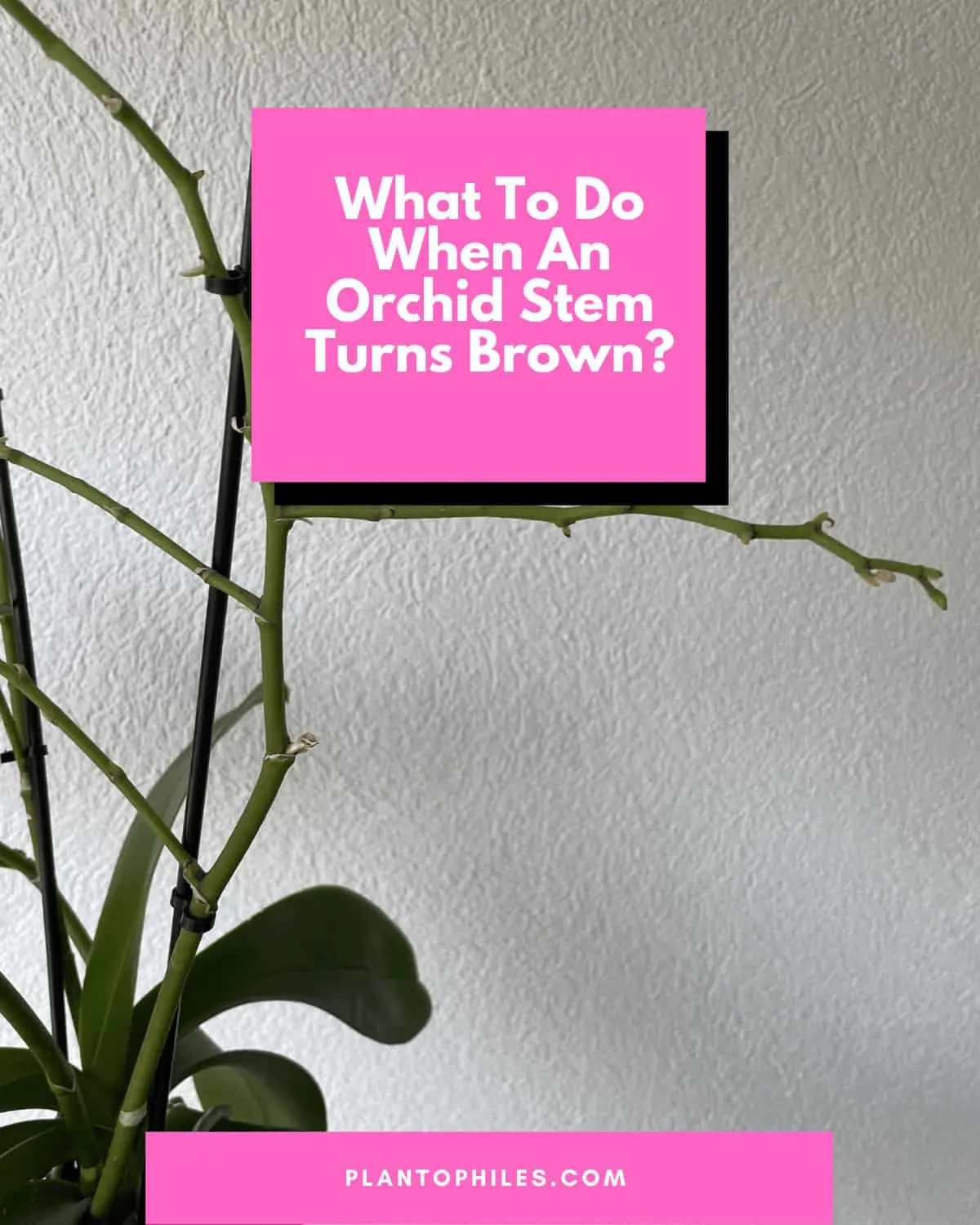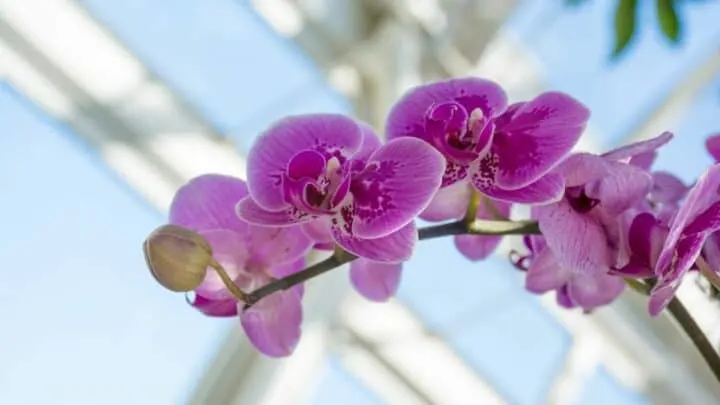With their breathtaking blooms, orchids possess an exotic quality that makes them an attractive choice for plant lovers.
I’m sure many people can attest to how easy it is to be lured in by an orchid’s gorgeous flowers when displayed at a garden center or grocery store.
Before you know it, you’ve bought one.
Many new owners may be unsure what to do once an orchid’s blooms disappear and its stem turns brown.
Table of Contents
What to do when an orchid stem turns brown?
There are two ways to deal with orchid stems turning brown. The first is to cut back the stem below the browning section one inch above a node. This may encourage it to branch off with and rebloom. The second option is to cut the stem off at its base, preserving the plant’s valuable energy for new leaf and root growth.

Why Orchid Stems Turn Brown
An orchid stem, or flower spike, is the tall green part of the orchid that bears its beautiful blooms. When an orchid is finished flowering, it is normal for these spikes to turn brown.
Flowering expends a tremendous amount of the plant’s energy. By sacrificing its flower spike, an orchid allows itself to rest.
This way, it can redirect its energy toward growing new strong roots and leaves.
Once an orchid has finished blooming, it is normal to enter a state of dormancy.
During this time, the plant can recuperate and prepare itself to produce new flower spikes for the following flowering season.
How And Why Trimming My Flower Spikes Is Important
Trimming a flower spike and cutting it back are two completely different methods of dealing with dying stems.
There are no hard or fast rules about which way is superior, and many other factors contribute to a successful reblooming, such as overall plant health and growing conditions.
Often, but not always, trimming back a dying flower spike above a node can result in a second bloom.
This occurs when a new shoot emerges from an existing stem that has been cut.
The chances of this type of regrowth are increased if the plant is big and healthy with an extensive root system.
First, inspect the flower spike. With this method, chances of regrowth are improved if the browning has not yet reached the halfway point of the stem.
Furthermore, there must still be healthy stem nodes present.
Next, ensure that your scissors or shears are clean and sterilized. This minimizes the risk of spreading germs or diseases to plants and is essential to caring for them.
Once cut, the stem can be treated with cinnamon, a natural fungicide.
How To Cut Back A Stem At Its Base
If a plant is young and weak to moderate root system, I recommend cutting back dying flower spikes at the base.
Doing so removes the orchid’s pressure and redirects its energy to growing new roots and leaves. It also encourages a fuller bloom in the coming season.
Plant parents can either cut back the spike once the plant has finished blooming or wait until it starts to wither and turn brown.
Either way, the same steps as above should be followed, in that cutting tools should be clean and sterilized, and exposed stems treated with cinnamon.
Post-trim is also an excellent time to repot an orchid. It is about to enter a state of dormancy, so giving it a little boost in the form of new nutrient-rich soil can only assist it on its way.
Orchid soil mixes tend to break down over time, so annual repotting is advisable.
Related: Why does my orchid stem turn yellow
How To Recognize New Stem Growth
When identifying new growth on a trimmed flower spike, look for offshoots and healthy growth near the node when the plant was snipped.
In the case of brand-new flower spikes, one can recognize them by their glossy dark green points, which differ from the plant’s lighter and more rounded green-grey roots.
With bright indirect light, cooler temperatures, and several other tips, you can speed up the growth of new stems. Read more about how to make an orchid grow a new spike.
Related: Why is my orchid stem turning yellow
Frequently Asked Questions About What to Do When Orchid Stem Turns Brown
Should I fertilize my orchid after trimming it?
When orchids are not in bloom, they should be fertilized every one to two weeks using a balanced product, such as a 10-10-10 fertilizer. Pro orchid growers recommend dosing orchids with more frequent but diluted applications rather than with less frequent full-strength applications.
I’ve trimmed back my flower spike, but my orchid won’t rebloom?
Cutting back an orchid’s flower spike gives it its best chance of reblooming, but other factors may also come into play. A plant that is not receiving adequate light or warmth will not rebloom. Unhealthy root systems and incorrect watering protocols will also negatively impact its growth.
Why is my new orchid spike changing into a yellow color?
The growth of a new flower spike is incredibly pleasing for orchid owners but can also fill them with crippling disappointment if the shiny green stem suddenly turns to pale yellow. Coloring of this nature indicates that the orchid is in trouble. Reasons for yellowing flower spikes include nutrient deficiencies, dry growing medium, sudden temperature changes, or the presence of ethylene gas in the environment.
Conclusion
Contrary to what many people think, orchids are easy-to-care-for plants.
They are also good at communicating what stage of their growth cycle, so paying attention to these signs makes it easy to identify the plant’s needs.
With some knowledge and upkeep, orchids will spoil their owners with beautiful blooms season after season.

Daniel has been a plant enthusiast for over 20 years. He owns hundreds of houseplants and prepares for the chili growing seasons yearly with great anticipation. His favorite plants are plant species in the Araceae family, such as Monstera, Philodendron, and Anthurium. He also loves gardening and is growing hot peppers, tomatoes, and many more vegetables.


